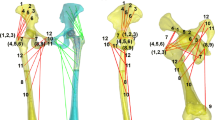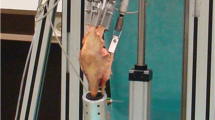Abstract
Background
Anatomical reconstruction in total hip arthroplasty (THA) allows for physiological muscle function, good functional outcome and implant longevity. Quantitative data on the effect of a loss or gain of femoral offset (FO) are scarce. The aim of this study was to quantitatively describe the effect of FO changes on abductor moment arms, muscle and joint reactions forces.
Methods
THA was virtually performed on 3D models built from preoperative CT scans of 15 patients undergoing THA. Virtual THA was performed with a perfectly anatomical reconstruction, a loss of 20% of FO (−FO), and a gain of 20% of FO (+FO). These models were combined with a generic musculoskeletal model (OpenSim) to predict moment arms, muscle and joint reaction forces during normal gait cycles.
Results
In average, with −FO reconstructions, muscle moment arms decreased, while muscle and hip forces increased significantly (p < 0.001). We observed the opposite with +FO reconstructions. Gluteus medius was more affected than gluteus minimus. −FO had more effect than +FO. A change of 20% of FO induced an average change 8% of abductor moment arms, 16% of their forces, and 6% of the joint reaction force.
Conclusions
To our knowledge, this is the first report providing quantitative data on the effect of FO changes on muscle and joint forces during normal gait. A decrease of FO necessitates an increase of abductor muscle force to maintain normal gait, which in turn increases the joint reaction force. This effect underscores the importance of an accurate reconstruction of the femoral offset.






Similar content being viewed by others
References
Pauwels PF (1973) Biomechanische Analyse und kausale Therapie der Coxa vara congenita, Schenkelhalspseudarthrose und Coxarthrose. Atlas Zur Biomech Gesunden Kranken Hüfte. Springer, Heidelberg, pp 39–269
Bombelli R (1976) Osteoarthritis of the hip: pathogenesis and consequent therapy. Springer, Berlin
Sariali E, Klouche S, Mouttet A, Pascal-Moussellard H (2014) The effect of femoral offset modification on gait after total hip arthroplasty. Acta Orthop 85:123–127. doi:10.3109/17453674.2014.889980
Terrier A, Levrero Florencio F, Rudiger HA (2014) Benefit of cup medialization in total hip arthroplasty is associated with femoral anatomy. Clin Orthop Relat Res 472:3159–3165. doi:10.1007/s11999-014-3787-3
McGrory BJ, Morrey BF, Cahalan TD et al (1995) Effect of femoral offset on range of motion and abductor muscle strength after total hip arthroplasty. J Bone Joint Surg Br 77:865–869
Sakalkale DP, Sharkey PF, Eng K et al (2001) Effect of femoral component offset on polyethylene wear in total hip arthroplasty. Clin Orthop 388:125–134
Little NJ, Busch CA, Gallagher JA et al (2009) Acetabular polyethylene wear and acetabular inclination and femoral offset. Clin Orthop 467:2895–2900. doi:10.1007/s11999-009-0845-3
Sariali E, Mauprivez R, Khiami F et al (2012) Accuracy of the preoperative planning for cementless total hip arthroplasty. A randomised comparison between three-dimensional computerised planning and conventional templating. Orthop Traumatol Surg Res 98:151–158. doi:10.1016/j.otsr.2011.09.023
Hassani H, Cherix S, Ek ET, Rudiger HA (2014) Comparisons of preoperative three-dimensional planning and surgical reconstruction in primary cementless total hip arthroplasty. J Arthroplasty 29:1273–1277. doi:10.1016/j.arth.2013.12.033
Rüdiger HA, Parvex V, Terrier A (2016) Impact of the femoral head position on moment arms in total hip arthroplasty: a parametric finite element study. J Arthroplasty 31:715–720. doi:10.1016/j.arth.2015.09.044
Cassidy KA, Noticewala MS, Macaulay W et al (2012) Effect of femoral offset on pain and function after total hip arthroplasty. J Arthroplasty 27:1863–1869. doi:10.1016/j.arth.2012.05.001
Mahmood SS, Mukka SS, Crnalic S et al (2016) Association between changes in global femoral offset after total hip arthroplasty and function, quality of life, and abductor muscle strength. Acta Orthop 87:36–41. doi:10.3109/17453674.2015.1091955
Bjordal F, Bjorgul K (2015) The role of femoral offset and abductor lever arm in total hip arthroplasty. J Orthop Traumatol 16:325–330. doi:10.1007/s10195-015-0358-7
Delp SL, Loan JP, Hoy MG et al (1990) An interactive graphics-based model of the lower extremity to study orthopaedic surgical procedures. IEEE Trans Biomed Eng 37:757–767
Terrier A, Parvex V, Rudiger HA (2016) Impact of individual anatomy on the benefit of cup medialization in total hip arthroplasty. HIP Int. doi:10.5301/hipint.5000392
Wu G, Siegler S, Allard P et al (2002) ISB recommendation on definitions of joint coordinate system of various joints for the reporting of human joint motion—part 1: ankle, hip, and spine. J Biomech 35:543–548
Sherman MA, Seth A, Delp SL (2013) What is a moment arm? Calculating muscle effectiveness in biomechanical models using generalized coordinates. ASME Pap. (V07BT10A052)
Gordon AM, Huxley AF, Julian FJ (1966) The variation in isometric tension with sarcomere length in vertebrate muscle fibres. J Physiol 184:170–192. doi:10.1113/jphysiol.1966.sp007909
Farmer KW, Jones LC, Brownson KE et al (2010) Trochanteric bursitis after total hip arthroplasty: incidence and evaluation of response to treatment. J Arthroplasty 25:208–212. doi:10.1016/j.arth.2009.02.008
Capogna BM, Shenoy K, Youm T, Stuchin SA (2017) Tendon disorders after total hip arthroplasty: evaluation and management. J Arthroplasty. doi:10.1016/j.arth.2017.04.015
Iorio R, Healy WL, Warren PD, Appleby D (2006) Lateral trochanteric pain following primary total hip arthroplasty. J Arthroplasty 21:233–236. doi:10.1016/j.arth.2005.03.041
Sayed-Noor AS, Sjödén GO (2006) Greater trochanteric pain after total hip arthroplasty: the incidence, clinical outcome and associated factors. HIP Int 16:202–206
Clement ND, Patrick-Patel RS, MacDonald D, Breusch SJ (2016) Total hip replacement: increasing femoral offset improves functional outcome. Arch Orthop Trauma Surg 136:1317–1323. doi:10.1007/s00402-016-2527-4
Meireles S, De Groote F, Reeves ND et al (2016) Knee contact forces are not altered in early knee osteoarthritis. Gait Posture 45:115–120. doi:10.1016/j.gaitpost.2016.01.016
Skalshøi O, Iversen CH, Nielsen DB et al (2015) Walking patterns and hip contact forces in patients with hip dysplasia. Gait Posture 42:529–533. doi:10.1016/j.gaitpost.2015.08.008
Donnelly CJ, Lloyd DG, Elliott BC, Reinbolt JA (2012) Optimizing whole-body kinematics to minimize valgus knee loading during sidestepping: implications for ACL injury risk. J Biomech 45:1491–1497. doi:10.1016/j.jbiomech.2012.02.010
Reinbolt JA, Seth A, Delp SL (2011) Simulation of human movement: applications using OpenSim. pp 186–198
Valente G, Pitto L, Testi D et al (2014) Are subject-specific musculoskeletal models robust to the uncertainties in parameter identification? PLoS ONE 9:e112625. doi:10.1371/journal.pone.0112625
Myers CA, Laz PJ, Shelburne KB, Davidson BS (2014) A probabilistic approach to quantify the impact of uncertainty propagation in musculoskeletal simulations. Ann Biomed Eng 43:1098–1111. doi:10.1007/s10439-014-1181-7
Lengsfeld M, Bassaly A, Boudriot U et al (2000) Size and direction of hip joint forces associated with various positions of the acetabulum. J Arthroplasty 15:314–320. doi:10.1016/S0883-5403(00)90624-7
Amirouche F, Solitro G, Walia A (2016) No effect of femoral offset on bone implant micromotion in an experimental model. Orthop Traumatol Surg Res 102:379–385. doi:10.1016/j.otsr.2016.01.010
Author information
Authors and Affiliations
Corresponding author
Ethics declarations
Conflict of interest
The authors declare that they have no conflict of interest.
Ethical approval
The study is based on previously published finite element models, which are derived from CT scans of 15 of our patients. The use of this numeric model has been approved by our IRB.
Rights and permissions
About this article
Cite this article
Rüdiger, H.A., Guillemin, M., Latypova, A. et al. Effect of changes of femoral offset on abductor and joint reaction forces in total hip arthroplasty. Arch Orthop Trauma Surg 137, 1579–1585 (2017). https://doi.org/10.1007/s00402-017-2788-6
Received:
Published:
Issue Date:
DOI: https://doi.org/10.1007/s00402-017-2788-6




